If you’ve ever stumbled across a baseball card and found yourself wondering what exactly you’re holding, you’re not alone. Identifying a baseball card can be an exciting and sometimes confusing task. Whether you’ve inherited a stack from a family member, discovered a gem at a garage sale, or simply pulled a card from a modern pack, learning how to identify a baseball card is a key skill for any collector.
This guide will walk you through the step-by-step process to determine a card’s year, manufacturer, card number, and whether it’s a base card, insert, parallel, vintage, or reprint. With the right approach and tools, you can look up and identify a baseball card in seconds.
What It Means to Identify A Baseball Card
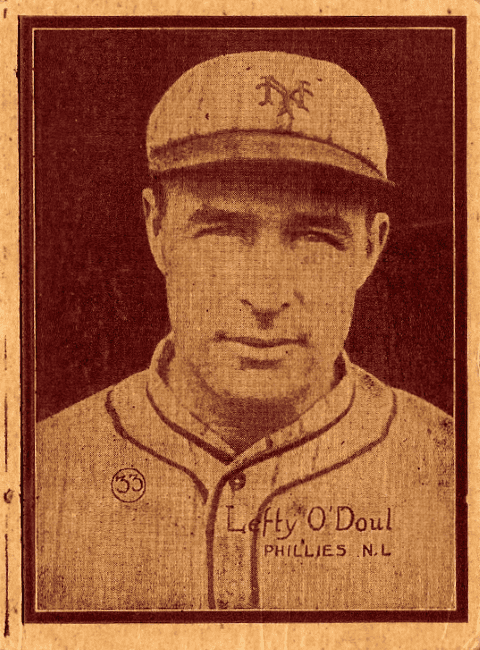
Identifying a baseball card means knowing the year, manufacturer, subset/insert, parallel (if applicable), player and number. All of these tell the full story of a baseball card, and industry-wide, this is the most common format:
[Year*] [Manufacturer*] [Subset] [Insert] [Parallel] [Player Name*] [Number] [Serial Number]
Only the year, manufacturer and player name are required, although a number is very common too. Other aspects are optional and depend on if they’re relevant to that particular card. Here are some examples of what this looks like in practice:
- 1911 T205 Gold Border Ty Cobb
- 1975 Topps George Brett #228
- 2022 Donruss Diamond Kings Artist’s Proof Silver Aaron Ashby #146 /99
So why does it matter? Correctly identifying a baseball card is the first step to understanding its value, rarity, and historical context. It allows you to:
- Catalog your collection accurately
- Assess condition and compare to known standards
- Determine market value
- Decide whether to grade the card
- Spot fakes and reprints
Each of these steps begins with proper identification. Let’s break it down into manageable parts so you can quickly analyze any card that comes your way.
Step 1: Check the Back of the Card
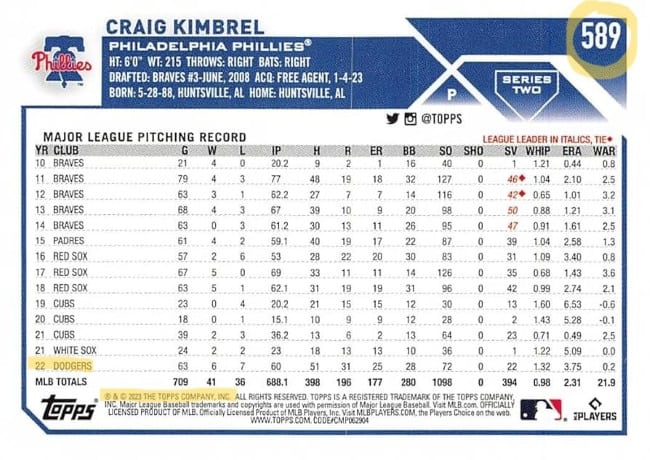
It might seem counterintuitive, but the back of a card holds far more detailed information than the front. Whether it’s the rough monochromes of vintage cards or a glossy modern card, there are several places to look for clues about what card you have.
Locating the Year
The number one way to identify a baseball card by year is to look at the copyright. Most cards from the late 1970s onward include a copyright year in small print, usually along the bottom edge. This year often (but not always) matches the year of issue. For example, a card with “1986 Topps Chewing Gum, Inc.” likely comes from the 1986 set.
However, copyright years can sometimes lag the actual release by one season, especially in modern releases that include stats through the previous year.
This is where reprints might standout. While a real Mickey Mantle rookie card, for example, does not have a copyright date, a reprint will show that the card was produced much later than the original in 1952. This is a dead giveaway that the card is not an original.
When copyright dates are missing, look at the stat line. The most recent season listed can offer a good clue to the card’s release. For instance, if the last season shown is 1990, there’s a high likelihood the card was issued in 1991.
Finding Manufacturer Info
In most cases, the manufacturer’s name is displayed clearly on the front, so identifying a baseball card by manufacturer is that simple. However, if you’re stuck, the manufacturer is often listed with the copyright too. Phrases like “Printed in USA by Upper Deck Company, LLC” or “Topps Company, Inc.” can clarify the manufacturer.
However, it’s important to keep in mind, with modern releases, that there are brands and there are manufacturers. For example, Topps manufactures Bowman, and Panini manufactures Donruss. Therefore, a card with a Topps copyright may be a Bowman card, or may be from another Topps brand like Topps Pristine or Topps Heritage.
Card Number

The card number is crucial for identification. This number is typically located in a corner or along the top or bottom. It provides vital clues about the type of card you’re holding. Here are some general rules for numbering:
- Regular numbers (1, 20, 600) are typically reserved for base cards
- Prefixes and suffixes tell you if it’s an insert, and they almost always follow the pattern of the name of the set. For example, Stars of the MLB cards are numbered as SMLB-1, SMLB-30, etc.
- Additional letters can refer to parallels. In the Stars of the MLB example, CSMLB-1 is a Chrome version.
- Numbers and letters can tell you the type of insert or parallel. For example, SPPPQR-MY may look like a word jumble, but it stands for “Single Player Primary Pieces Quad Relic Mike Yastrzemski,” which is part of the Topps Museum Collection set.
See if you can decode these examples:
- T1R-KMA: Tier One Relic Ketel Marte
- MMR2-LW: Meaningful Material Relic (Series 2) Logan Webb
- T90C-48: Topps 1990 Chrome #48 (an insert from the 2025 Topps flagship set)
- 23GH-28: 2023 Greatest Hits #28 (an insert from 2024 Topps)
- CLRS-11 – Complex League Rising Stars #11 (an insert from 2024 Topps Pro Debut)
Step 2: Analyze the Front of the Card

The front of the card holds essential visual clues that can point you in the right direction.
Player Name
This is the most obvious starting point. Search engines and card databases rely on keywords, and the player’s name is critical. If the card features a lesser-known or minor league player, look closely for any name spelling or middle initials. Pay close attention to cards that are shared with other players. These are the easiest to search for, since it’s fairly unique for one player to be pictured with another often in his career.
For specialty cards, you can also use the information given. For example, a “1968 League Leaders” card was likely produced in 1969, not 1968, since the events depicted on the card hadn’t happened yet. This is true for modern releases too, like Topps Greatest Hits inserts. The events on a 2024 Topps Greatest Hits card are from 2023.
Manufacturer Logos
Most modern cards feature a manufacturer’s logo on the front. Common brands include:
- Topps
- Bowman (a Topps brand)
- Panini
- Donruss
- Fleer
- Upper Deck
Recognizing the logo can quickly help you identify the card’s manufacturer, which is essential for identifying a baseball card. Logos can also identify brands, which are produced by manufacturers. For example, Heritage, Pristine, Tier One, Museum Collection, Chrome and many others are all brands of Topps cards, which have unique logos for each brand.
Team and Uniform
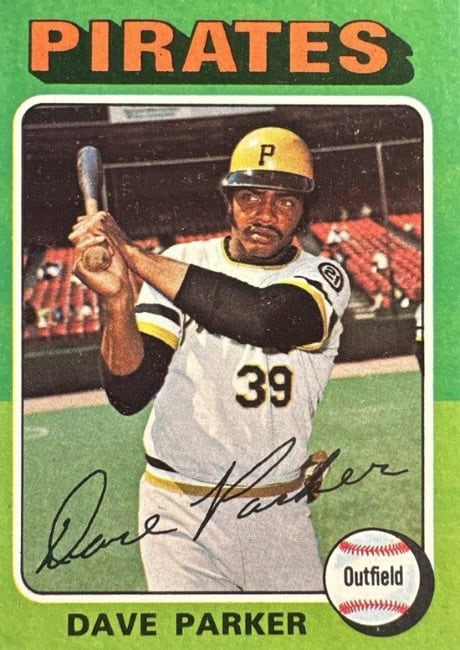
The team name and uniform style can help narrow down the card’s era. Logos, jersey designs, and team colors often evolve over time. Uniform details might even help pinpoint the card to a specific year range if you’re unsure of the decade. In some cases, a player only appeared with a team for one year, such as Dave Parker for the Blue Jays. This can be a dead giveaway of when the card was made. As with dates, you’re typically looking for the year after what’s depicted. Using the Parker example, he played for the Blue Jays in 1991, so his 1992 cards depict him in a Toronto uniform. Likewise, if you know that the Pirates only wore pillbox caps in 1977, that can also help you narrow down a search.
There are exceptions, like cards that are made late in the season. These “Traded” or “Update” sets may show a player with a team they joined mid-year, such trading deadline deals. Even if a team or uniform can’t get you an exact date, it will put you in the right ballpark.
Brand Logos
Most modern cards feature a manufacturer’s logo on the front. Common brands include:
- Topps
- Bowman (a Topps brand)
- Donruss
- Fleer
- Upper Deck
- Score
- Leaf
Recognizing the logo can quickly help you identify the card’s manufacturer, which is essential for searching.
Visual Style and Design
Each set has a distinct design. A horizontal layout, bright borders, player action shots, or vintage artwork can help match the card to a specific year or set. Once you’ve seen a few examples from popular sets, like 1987 Topps (with its woodgrain borders) or 1991 Fleer (with its bright yellow background), you’ll start to associate those styles with specific releases, and that makes it much easier to identify a baseball card.
Step 3: Spotting Parallels
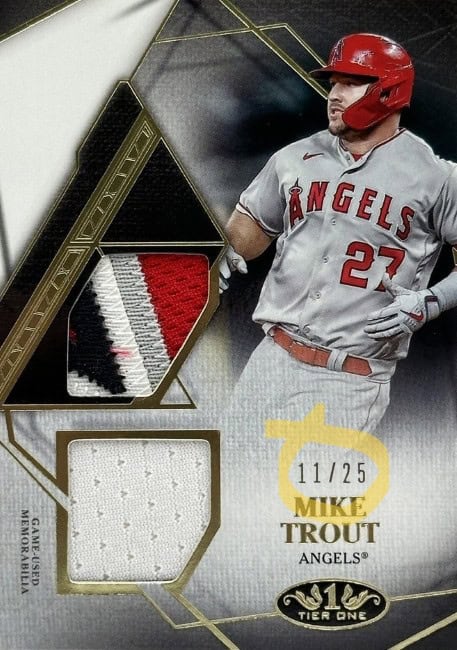
Parallels are types of cards that have a difference finish from the regular card. Depending on the parallel, they can be relatively common or extremely rare. Making sure you’re identifying a baseball card and any possible parallel is essential to determining what you hold in your hand and how valuable it is.
Serial Numbers
One of the easiest ways to spot a parallel is if it has a serial number. Serial numbers can range from the 1000s all the way to the elusive 1/1s, where only one card has been made. Look carefully for serial numbers, which can be printed – usually in foil – anywhere on the front or back. If you’d already figured out what type of card you have, a quick image search will tell you where to find the serial number. Otherwise, since there’s no standard, you simply have to look closely.
When you’re identifying a baseball card that has a serial number, that number can help you identify the parallel too. For example, if you have a green foil modern-day Topps card with a serial number out of 499, those facts all confirm each other to be true.
Different Card Finishes
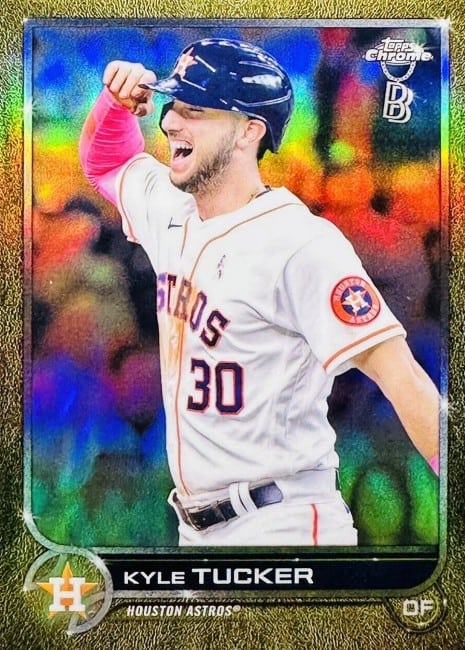
Identifying a baseball card’s finish is much more difficult sometimes. Products like Topps flagship have over 50 parallels, some without serial numbers. How can you tell if the card in your handle is a rainbow foil, a diamanté, sandglitter, confetti, or something else? Trust me, this is where it can get difficult!
If you pulled the card from a pack, retrace your steps and try to find out what kind of pack or box it came from. Many parallels are unique to a certain type of box, and can be identified that way.
In cases where you didn’t pull it directly from a pack, image search is your friend. Find a checklist – Topps publishes theirs online – and locate the type of parallel you think you have. (For example, if you have a silver card, you know it’s not a green parallel). Then, search for what are called exemplars. These are cards that we know are accurate examples of each kind of parallel. So, for example, if you search for rainbow foil but you see the examples don’t have the same pattern as your card, you can rule out that parallel.
If this sounds like the real detective work, it is! Identifying a baseball card parallel is an expert-level skill in collecting, so don’t worry if you’re not good at it right away. Some day, you will be able to shuffle through cards quick and identify them by color, serial number and finish.
Step 4: Is This a Real Autograph?
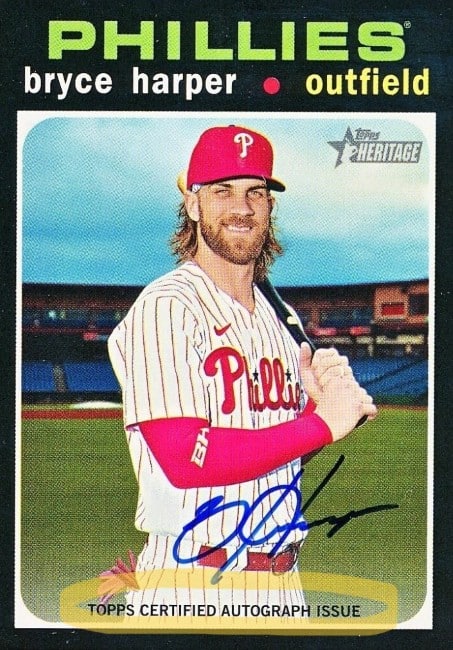
One of the biggest confusions for new collectors is whether they pulled a valuable autograph or a facsimile. Facsimile autographs refer to those that are printed on the card itself (a picture of a signature, essentially), vs. signed by the baseball player. Facsimile signatures go back to the early days of collecting, when sets like 1952 Topps included them as part of the design. Even modern cards, like 1989 Bowman and many Topps Heritage releases, have facsimile signatures on the base cards.
So, how can you tell? There are four ways:
- Hold the card under the light or in the sunlight. Tilt it slowly and see if the signature glows or flashes. If it does, you have a real autograph! If it reacts exactly like the rest of the card, it’s been preprinted.
- Check for characteristics of an autograph. Nearly all current autographs are signed with blue Sharpie markers, not the ballpoint pen-style that you’ll see with facsimiles.
- Modern cards will either print the autograph on a sticker, which is then affixed to the card, or they will have a designation printed on the card, like “Topps Certified Autograph.”
- Ask yourself: “Does the autograph make sense?” Consider when the player was alive, and the writing instruments of the time. Does the autograph look vintage (if it’s on an old card)? Was the player alive when that card was produced? In other words, a 1909-1911 T206 Christy Mathewson signed in bold Sharpie is, unfortunately, not real.
Step 5: Learn to Spot Reprints vs. Vintage Originals
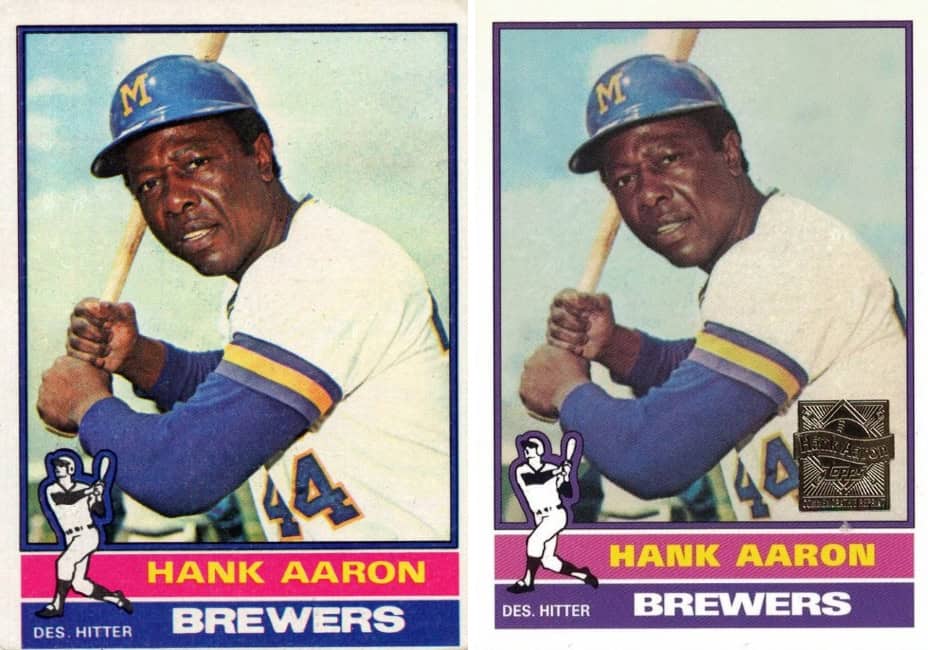
With the popularity of vintage sets, many companies have issued reprints – and learning to identify them is essential. Reprints are often produced with modern materials and slight visual differences, but they can look deceptively similar to originals.
Start by checking the card stock. True vintage cards often feel heavier, rougher, or more porous due to the printing technology of their time. Depending on their age, they can feel fragile in your hand. In contrast, reprints tend to use modern glossy or high-quality card stock that feels slicker and more uniform.
Next, examine the card back. Many reprints will include phrases such as “Reprint,” “Commemorative Edition,” or display a modern logo or foil stamp on the front. Comparing the card’s back to exemplars – available via image searches – can help confirm your findings. This is one area where online auction sites are not helpful. Type in “1976 Topps Hank Aaron” for example, and you’ll be inundated with reprints too, even if you filter your results. Sellers are sometimes myopic to the needs of collectors who want vintage cards.
Also, pay attention to the quality of the print. Older cards may show less precise color registration, slightly fuzzy edges, or printing dots under magnification, while reprints typically appear sharper and cleaner. Finally, check the copyright year. A reprint might replicate a 1950s card front but include a copyright date like 1999 or 2001, revealing it as a modern product. By learning these subtle distinctions, you’ll avoid mistaking reprints for valuable originals.
Step 6: Vintage Breaks All the Rules
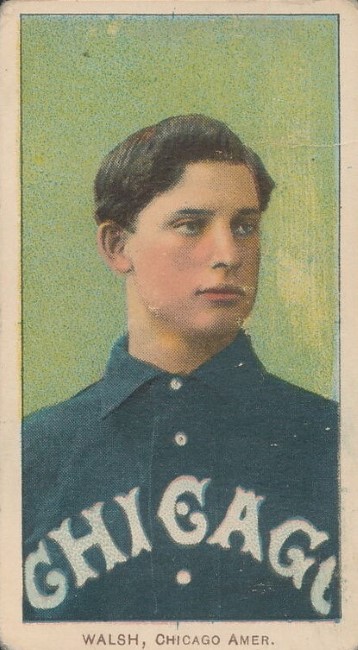
Identifying a baseball card is only as good as the clues you’re given. So what can you do when you have very few clues? Before the modern era of collecting, baseball cards were produced by smaller companies that were more interested in selling gum or tobacco than baseball cards. Therefore, they didn’t think to include copyrights, branding or numbering.
With these truly vintage cards, here’s what to do:
- Gather what you can. Is the player’s name on the card? Can you tell his team? What company produced the card (or is advertising on it)?
- Check the size. There was no standard size for baseball cards until the mid-1950s, so size can narrow down your options for pre-war cards.
- Check image search. The good news about vintage cards is that there aren’t a lot of different brands, like there are today. Searching for a phrase like “C. Mathewson NY Giants card” will bring you results for the handful of Christy Mathewson cards in existence.
- Send it for professional grading. There’s no easy way around this. If you think you have a genuine, valuable card, you should strongly consider sending it to a company like PSA OR SGC. They have the experience and tools necessary to identify and authenticate your card.
Identifying a Baseball Card’s Value

Once you know the card you have, you might be wondering if you’ve hit the jackpot:
- For modern cards, online auction sites and exchanges are the best way to gauge a card’s value. Keep in mind, the rarer your card, the more volatile the price!
- For vintage or rare cards, you may want to consider an auction house. They can tell you if the card will do well at an auction, and help you assign a value.
When you’re talking about valuable cards especially, the work you put in is returned to you through a higher sale price, in most cases. For example, an ungraded, unauthenticated T206 Honus Wagner pops up on eBay – Does anyone trust it’s real? The seller will get a fraction of the price, compared to if they had sent it for authentication. Even T206 Wagners that have been ripped in half sell when they’re authenticated!
The Value of Identification

When you properly identify a baseball card, you unlock more than just a name and number – you gain insight into its historical context, emotional resonance, and market value. For serious collectors, accurate identification is the first step toward authentication, grading, and determining a card’s rarity or significance. It also helps protect against counterfeits and clarifies a card’s place within a set. For casual fans, it offers a fun, rewarding way to explore baseball’s rich past and connect with iconic players and eras.
Whether you’re holding a century-old T206 tobacco card, a 1989 Upper Deck Ken Griffey Jr. rookie, or a modern 2023 Topps Chrome refractor, knowing how to identify a baseball card adds both meaning and confidence to your collecting journey. It transforms what might seem like a random piece of cardboard into a tangible piece of sports history – something worth preserving, understanding, and sharing.
Next time someone hands you a mysterious card and asks, “What is this?”, you’ll know exactly where to start. Identifying a baseball card is the key that opens the door to everything else – collection management, value assessment, grading, and storytelling.
Take the time to master this process, and you’ll be the go-to expert in your card-collecting circle.

